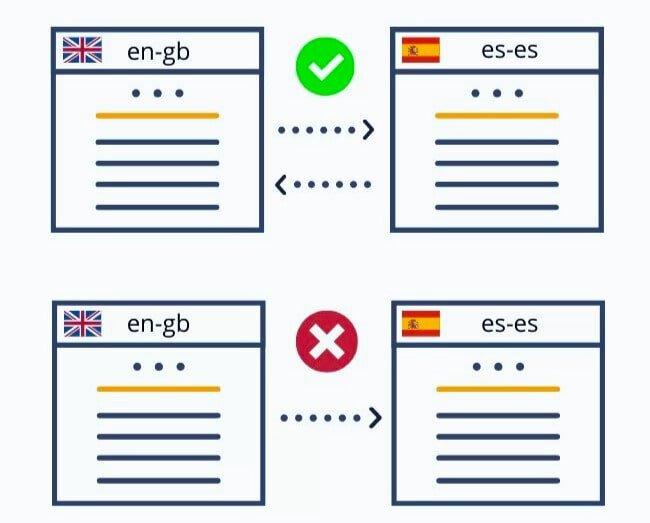Introduction To Hreflang Tags Attributes
Hreflang tag attributes are an HTML language that provides a signal to search engines about the language and geographical targeting of a specific webpage. It was introduced by Google in December 2011. It is used to indicate alternative versions of the same content in different languages or for different regions when you have created content for a specific region. According to Antraajaal, by using correct hreflang tags, you can guide search engines in providing the most relevant versions of your content to users based on their language and location preferences. It is important for International SEO.
Code Sample:
link rel=”alternate” href=”https://example.com” hreflang=”en-us” />
For India [<link rel=”alternate” href=”https://antraajaal.com/” hreflang=”en-in” />]
For united states [<link rel=”alternate” href=”https://antraajaal.com/” hreflang=”en-us” />]
For Russia [<link rel=”alternate” href=”https://antraajaal.com/” hreflang=”en-ru” />]
Hreflang=”en-us”?
” Language – Country ” – “en-us” (English – United States)
” Language – Country ” – “hi-us” (Hindi – United States)
” Language – Country ” – “ru-us” (Russian– United States)
Why Are Hreflang Tags Important?
Hreflang tags are essential for international SEO because they help search engines understand the language and geotargeting of your webpage or content in terms of providing the most relevant information for certain search queries. It tells google that a web page contains multiple languages and regional variations. Without Hreflang tag attributes, search engines might mistakenly show the wrong language version of your content, which leads to poor user experience and potentially lower ranking.
How To Implement Hreflang Tags Attributes?
After you understand the importance of Hreflang tags let’s divide the process of implementing them into step-by-step to put them correctly on your website:
Step 1: Determine Your Target Languages and Regions
It is crucial to identify the languages and regions you want to target before implementing hreflang tags. According to the Hreflang tag attributes, conduct research to understand your target audience and their preferred languages. Also, consider factors such as location and market demand to ensure you are targeting the right regions effectively.
Step 2: Implement the Hreflang Tag in HTML
To implement the hreflang tag, you need to add it to the HTML code of your webpages. Here’s how you can do it:
Open HTML
<link rel=”alternate” hreflang=”xx-YY” href=”https://www.yourwebsite.com/page” />
Replace “xx-YY” with the appropriate language and region code for the specific page.
For example, “en-us” represents English content targeted at users in the United States. Ensure that you include the correct URL for each page you want to target.
<link rel=”alternate” hreflang=”en-us” href=”https://antraajaal.com/page” />
Step 3: Use the X-default Tag
Including the x-default tag is essential to handle situations where a page doesn’t have a specific language or region variant. According to the Hreflang tag attributes, it helps search engines understand that this is the default version of your page. Add x-default after you are done with your Hreflang tag for a specific language or region.
Open HTML
<link rel=”alternate” hreflang=”en-us” href=”https://antraajaal.com/page” />
<link rel=”alternate” hreflang=”x-default” href=”https://antraajaal.com/default” />
Replace the href attribute with the URL of your default page.
Step 4: Verify Hreflang Tag Implementation
To ensure that you’ve implemented hreflang tags correctly, it’s vital to verify their functionality. Google Search Console provides a useful tool called “International Targeting” report that allows you to check for any errors or issues with your hreflang tags. According to the Hreflang tag attributes, use this tool to identify and fix any problems that may arise during the implementation process.
Step 5: Monitor and Maintain
Once you’ve implemented hreflang tags, it’s essential to regularly monitor their performance and make any necessary adjustments. Monitor your website’s traffic, rankings, and user engagement to ensure that the implemented hreflang tags are effectively targeting your desired regions and languages. According to the Hreflang tag attributes, stay updated with any changes in your target audience’s preferences to adapt your hreflang strategy accordingly.
Benefits of Properly Implemented Hreflang Tags
Properly implemented hreflang tags can yield several benefits for your website:
- Enhanced user experience: Users will be led to the most up-to-date version of your material, which will improve their overall experience.
- Increased visibility in search results: According to the Hreflang tag attributes, you can increase your exposure in search engine results pages by offering appropriate language and region-specific versions of your content.
- Targeted traffic and higher conversion rates: Hreflang tag allows you to attract targeted traffic from specified locations, resulting in higher conversion rates and better business results.
- Reduced duplicate content issues: Hreflang tags can help avoid duplicate content issues that can develop when targeting different languages or locales by directing search engines to the correct version of your content.
How Hreflang Tags Impact Mobile SEO?
It is crucial to consider the impact of Hreflang tag attributes on mobile SEO. As more users access the web through their smartphones, ensuring that the correct language and region-specific versions are served becomes even more important. By implementing Hreflang tags properly and optimizing your website for mobile devices, you can enhance the user experience and improve your mobile search rankings.
Conclusion
Hreflang tag attributes are an essential component of international SEO because they allow you to deliver language- and region-specific versions of your content to users around the world. You can enhance user experience, increase exposure in search results, and attract targeted traffic to your website by properly employing hreflang tags and following best practices. To maximize the benefits of your online presence, keep up to date with the latest advances in hreflang tag implementation. For more updates regarding Digital Marketing stay connected with – Antraajaal


